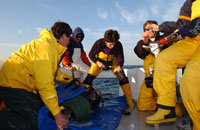Submitted by John Holdsworth, Pete Saul, Tim Sippel, and George Shillinger
Hopes were high for a successful conclusion of the pop-up satellite tagging in the second week. To maximize our tag deployment efforts, George Shillinger (see his blogs #3 and 5) transferred to the Cerveza 2, leaving Pete, Tim, and John to continue with working with the Cova Rose. As both teams prepared to depart, the weather had cleared again allowing the boats to leave the port of Greymouth on schedule.
The depth sounder showed that the fish were around but tended to stay down during the relatively calm first day of this second trip on the Cova Rose. The fish appeared to be hovering beside the hoki trawlers at 30 to 40 m, too deep for our baits until the feeding frenzy started as the trawl net surfaced (usually once every 3 or 4 hours).
Figure 1. Bluefin marks at 30-40 meters depth.

The hoki fishery attracts all sorts of attention from hungry marine animals. From above, tens of thousands of seabirds, from dainty petrels to huge wandering albatross, competed for scraps and whole hoki. From below New Zealand fur seals dart in and out of the chaotic scene, competing for easy hoki meals with our primary target, giant bluefin.
Figure 2. Tens of thousands of seabirds compete for scraps as the trawlers haul their nets.

A bait thrown into the mêlée at the right time could result in a hook up in seconds. If the tuna were too slow it wasn’t long before diving birds or an agile seal would have our bait at the surface and the opportunity could be missed.
Figure 3. Deckie Norm tosses a hoki bait as the trawler “Rehua” approaches while pulling its nets.

The crew on Cova Rose also had a number of tuna strikes the first day which did not result in hookups. Professor John Montgomery from the University of Auckland was in the chair for the first solid hookup. The 130 lb rod bowed and line peeled from the reel in the giant’s first run. Suddenly the weight seemed to double and the 130 lb nylon top-shot parted and the fish was gone. Possibly another large tuna had swum through the line.
This is a 24 hour a day fishery. In fact catches can be better at night and early morning. An angler must be in the chair and ready all the time our bait was in the water. Volunteers Graham McGregor (Ministry of Fisheries), John Montgomery and Arthur Cozens (University of Auckland) spent long hours on a cold and windy aft deck waiting for that hook-up.
It wasn’t until just after midnight in the waning hours of the charter that researcher and angler Tim Sippel (Auckland University and Blue Water Marine Research) brought a fish in range of the tag pole. Determination to bring a fish to the boat for tagging meant this solid 200 kg fish was online for just 32 minutes, and proved a little uncooperative at the boat. With the tag in place, wireman Norm was leading the fish toward the fish door to get a valuable fin clip for DNA analysis when it turned and snapped the 500 lb trace close to the hook.
Skipper Tony Roach “Chinner” put us back into the thick of more hungry bluefin and it wasn’t long before we had another solid hookup. John Holdsworth (Blue Water Marine Research) was the angler this time. There are not many heavy tackle fisheries left around the globe, but this is certainly one of them. It took a while to get used to the weight of the fish with the reel on sunset (40 kg over the rod tip) for almost the entire time. This fish, estimated 270 kg, took 47 minutes to get to the boat, tag and release. It departed with a couple of tail flicks and a shower of spray. Just two giant bluefin were tagged that trip, and both came in the early hours of 28 August, not long before we returned to Greymouth.
Figure 4. John Holdsworth hooks up just before dawn to catch the second and final fish tagged of the charter.

Meanwhile, George Shillinger and the team on board Cerveza 2 were also finding the fishing challenging. He describes his ensuing adventures in Blogs # 3 and # 5, while Pete Saul and Tim Sippel respectively describe their subsequent trips onboard the Cova Rose and Cerveza 2 in Blogs #4 and #6.




No comments:
Post a Comment